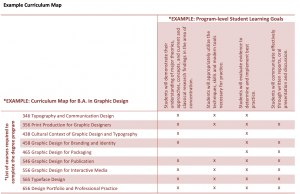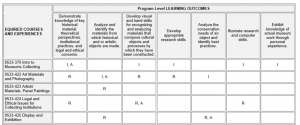11 Curriculum Mapping for Advancing Program Goals
Whether you’re engaging in curriculum mapping as part of your cyclical program review and self-study development, or as part of an ongoing effort to work with and improve your program’s curriculum, a helpful first step to is to consider your intentions, goals, and available resources for engaging in the Mapping. Doing so will allow you to effectively engage in the process to get the most out of the work. This section is oriented upon three initial questions you can ask yourself/your team to clarify a way forward:
What questions do we have about our curriculum that we’re hoping a curriculum map will address?
The question you focus on can influence and inform the type of data you collect and how you collect it. Here are some common questions programs ask of their curriculum and how that question informs the curriculum mapping activities employed:
Which courses connect to program learning outcomes? A basic curriculum map lists the courses/requirements that comprise a program and indicate which program learning outcomes the course/requirement is connected to or aligned with.

When, where, and how do students develop the knowledge/skills/values of our program learning outcomes? This map expands on the rudimentary format above by adding to the specificity of the data being collected. Here, individual course/requirement to program learning outcomes are mapped. For each course, instead of marking a simple X to show a relationship, consider marking with an indicator such as Introduce (I), Reinforce (R), or supporting Mastery (M) of the associated learning outcome. A first-year course, for example, might introduce students to concepts that they will apply in later courses, thus introducing them to learning that is essential to a program learning outcome of being able to critically apply those concepts to a range of contexts by the end of the program. Mapping all the courses in this way will show you how learning builds from course to course, where there may be overlaps or gaps, and where there are synergies.

Do core courses provide students with the learning and foundations we expect them to provide? This is a similar question to above, however it narrows the focus in on just the core courses. List the core courses/requirements of the program and map those to your program learning outcomes. At a minimum, are all outcomes introduced?
How do we know successful students are demonstrating their achievement of program learning outcomes upon graduation? This question places the focus on assessment, particularly in the last year, term, or last course(s) a student completes. Consider defining what structured learning opportunities students engage in at the end of their program (e.g. particular courses, a practicum placement, a defence). Narrow your curriculum mapping activities down to those identified elements and identify assessments within those experiences that align with program outcomes. For example, if the program learning outcome is the ability to effectively communicate in writing, then that major essay assignment in COUR 499 serves as one of the last points of assessment.
What are the common teaching activities and assessments being used by instructors of our program? If your question about teaching and assessment techniques is more broadly, set up your curriculum map to record and sort the range of different teaching strategies and assessment approaches being used across the curriculum – such as within individual courses or at certain critical points in the program (e.g. comprehensive exams). Consider listing all the courses and learning experiences that comprise the program, then documenting all major forms of teaching and assessment happening within each. It makes it easier if keywords or key terms can be agreed upon and clarified, so that the same language is being used by multiple people. For example, agreeing on a common understanding of tags like lecture, essay, presentation, or other words that best describe the types of teaching and assessment instructors of the program will wish to explicate.
It Takes a Village: Who will be involved and how?
None of the above questions can be answered solo. No one person holds the knowledge and often, the information is not fully represented or captured in documents like course syllabi. It takes input from members of the program’s community (e.g. tenured or tenure-track faculty, adjunct instructors, academic support staff; even students, alumni, teaching assistants).
Academic leaders (e.g. the Dean, Director, or Manager) can set up the parameters of curriculum mapping – what questions are being asked, how the work can be approached and set up. From there, they should look to engaging the community in the dialogue and conversation necessary for collective input. Common strategies include a collaborative online Excel spreadsheet that everyone can add to and edit, a Qualtrics survey set up to collect the specific information being sought from a wide number of people, Faculty retreats, or focused meetings.
How can Curriculum Mapping efforts be sustained?
Too often, programs put an incredible amount of work into a curriculum map that quickly becomes stale. Seven-years later, they feel obligated to start all over again because past versions are too outdated to be applicable. Consider how curriculum mapping will be part of ongoing and sustained program evaluation practices. Can your curriculum mapping document be set up and utilized as a living document – one that frequently gets referred to and updated so that it reflects the changing and ongoing development of your academic program?

